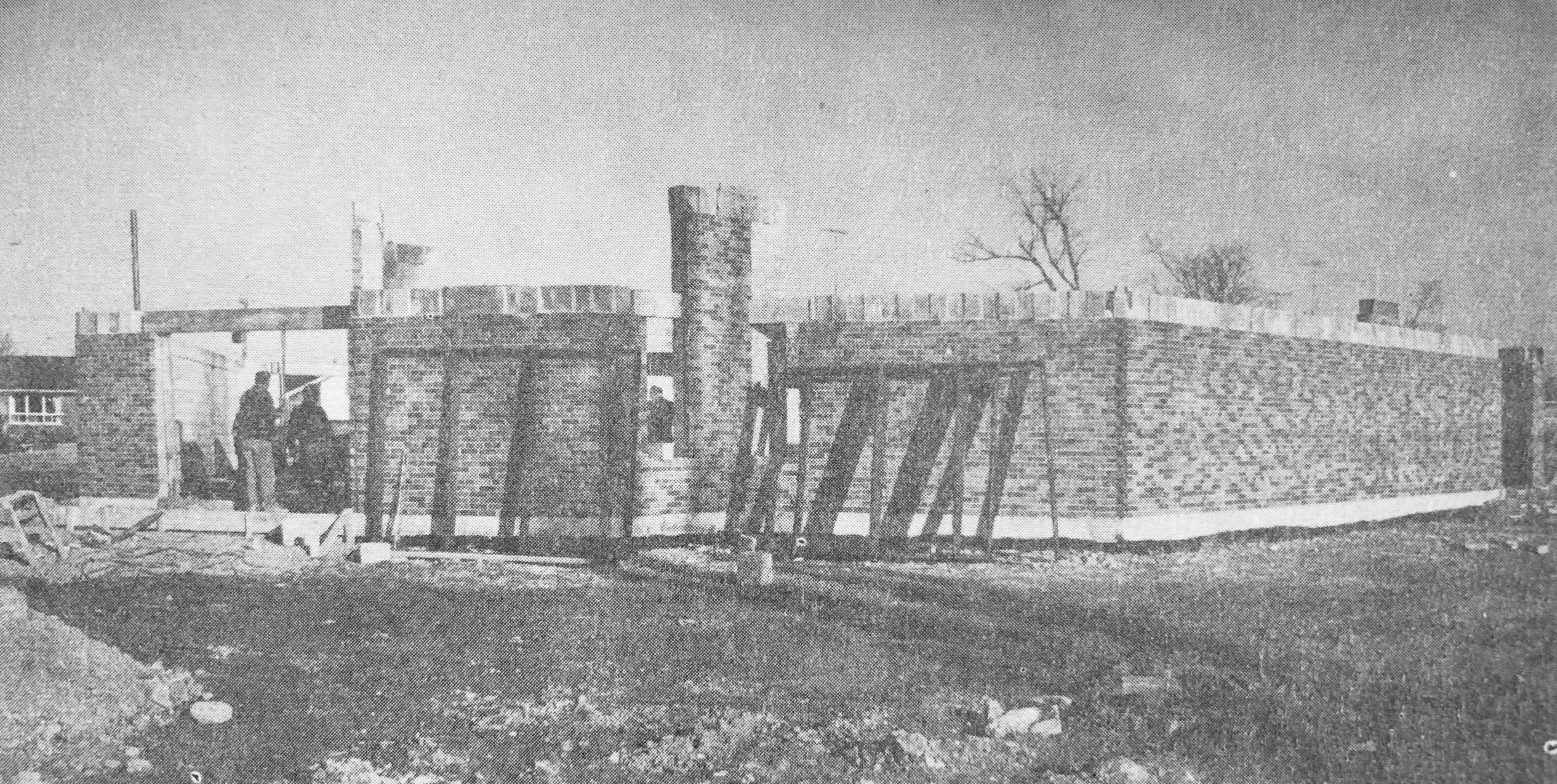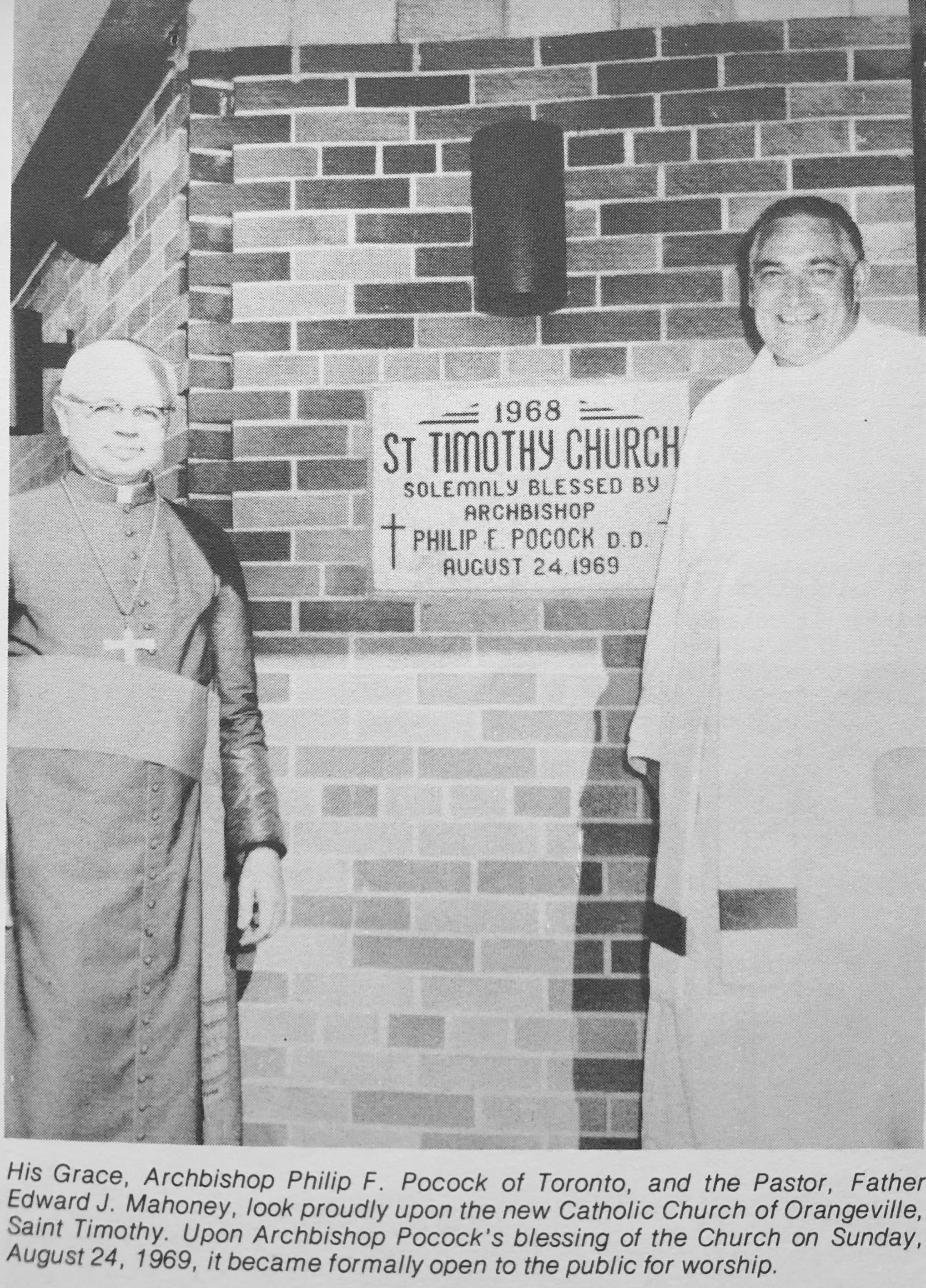
Our Parish History
The History Of St Peter’s Church, Orangeville
Roman Catholicism in the Orangeville area itself began in the farm house of one of its earliest and most devoted Catholic settlers, Patrick Ryan. Here visiting priests such as Father McSpiritt said Mass for many years for small number of Catholics living around Orangeville. The remains of the brick foundation of the old Ryan home, which burned down not many years ago, can still be seen right in the center of Lot. 1, Concession 3, W.H.S (West Of Hurontario Street), in Mono Township. By happy coincidence the Ryan farm today affords a fine view of both the modernistic spire of the new Saint Timothy Church, about 1 mile south-east in Orangeville proper, and of the Good Shepherd Manor to the north-east on the adjoining lot. Today, the Ryan farm is still used for farming but rumour has it that it will not be long before this historic site also falls before the developer’s bulldozer as Orangeville continues to expand westwards.
When the Toronto, Grey and Bruce Railroad reached Orangeville in 1871, it became clear that this former village was now slated for bigger things and that the influx of Catholics would require a formal place of worship. By 1873 Orangeville was a regular mission being served every second Sunday from Caledon. The Ryan farm now being too far removed from the centre of the town for most people, Mass was said in various private homes and commercial buildings in the Town of Orangeville itself.
The local Catholics made plans to build the church by themselves and for this purpose purchased a half acre lot on the east side of John Street, facing the railway station. However, they experienced so many difficulties from obstructionist and even destructionist forces that eventually the building contract was given over to a non-Catholic party, Messrs. Hewitt and Bullivant, who completed the task in less than 6 months.
The cornerstone of St Peter Church was laid on Sunday August 1, 1875, by Archbishop Lynch of Toronto, assisted by the Pastor, Father John Joseph Egan. Dean Harris, then Pastor Of Colgan, preached the sermon before the service and Archbishop Lynch preached after the ceremonies, each talking for about an hour on doctrinal matters and it was reported that two thousand were in attendance!
Archbishop Lynch soon returned again to bless the finished church at 11:30 a.m. on Saturday, January 1, 1876. A concert followed in the evening to complete the wintry New Year’s Day festivities. The future Dean Harris, now (former) Rector of St Michael's Cathedral, Toronto, again preached and tickets of admission to the ceremonies cost $1.00. The cost of the new church, slightly more than $2,000.00, was largely paid for such means as lectures, picnics, dinners and concerts.
The 30 by 50 foot compact red brick church was designed by the architect, F.G. Dunbar. The new church, situated on the east side of John Street just west of the C.P.R station and railway tracks, became a landmark and sign of pride to local Catholics. Over the years additions were made to it especially by Father Caroll who added on the Sacristy to the south-east corner of the building in 1930 and had a furnace installed in the basement. Father Caulfield later in the 1930’s had the rest of the basement dug out so that it might be used as a parish hall. Upstairs in the Sanctuary interior decorations and a number of stained glass windows were added over the years.
After the new St Timothy Church was opened in 1969, the old Saint Peter Church was sold and the building was soon adapted for business purposes in conformity with the surrounding area. Though much changed now from the way it once looked the building is still recognizable as a church and parishioners will for a long time fondly remember the old St Peter’s “by the tracks”. It served Orangeville’s Catholics for 93 years - to be exact from 11:30 a.m. January 1, 1876 until 7:30 p.m. Thursday June 19, 1969, the starting times of the first and last service to be held in it. After the latter service the parishioners processed over to the new Saint Timothy Church bearing with them the valuables and above all the spirit of the old Saint Peter Church.
But perhaps Orangeville’s greatest triumph was its becoming a Parish in its own right in 1885. This was no easy task because already there were signs of the population beginning to decline in the surrounding area even if Orangeville itself was growing as an important commercial centre and junction point of two railroads. No doubt the determination of Orangeville’s Catholics to have a church of their own and their willingness to support it financially convinced Archbishop Lynch to erect the new Parish at Orangeville rather than at perhaps Brampton or simply to have left a second priest at Caledon permanently. To this end, two well written letters from the parishioners were given to Archbishop Lynch, one of which is true Victorian English has been included on the following page.
Suffice it to say that the Catholics of Orangeville petitioned successfully and shortly afterwards Father Jeffcott arrived in Orangeville in 1885. He purchased a modest old house which is still standing at 80 Mill St and this became the first Rectory in Orangeville. In 1920 Father Bagnasco purchased a larger house at 21 Wellington Street which became the second Rectory and which is also still standing. It was sold in 1967 at which time the present Rectory, the third one, was being lived in. The present pastor (at the time), Father Ted Mahoney, chose the present Rectory at its 24 Hillside Drive address so that it would be a location much closer to Orangeville’s new catholic school and church in the growing suburbia on the south west side of orangeville.
As a new parish in 1885 Orangeville straightway received as missions the following three Catholic churches. Saint Cyprian at Granger was closed around 1900 and was only visited about once a month from Orangeville. On the other hand the priest said Mass every second Sunday at the Brampton and cataract churches in rotation. This practice continued after 1915 when Caledon took the place of Brampton as the other mission. Mass was always said every Sunday at Orangeville itself.
Father Caulfeild began the practice in the 1930s of having visiting Basilian Priests from St Michael's College, Toronto help out at the Masses at the Parish churches so that Mass could be said at all the missions every Sunday whenever such was feasible. However, it was not until Father Schwalm’s Pastorate in the late 1940’s that winter road clearing services became effective enough to assure Mass almost every Sunday at all the mission churches all the year - that is where the attendance would justify a Mass being said there. Today the situation is a relatively simple one. Saint Corneilus is the only mission and Mass there every Sunday can easily be assured.
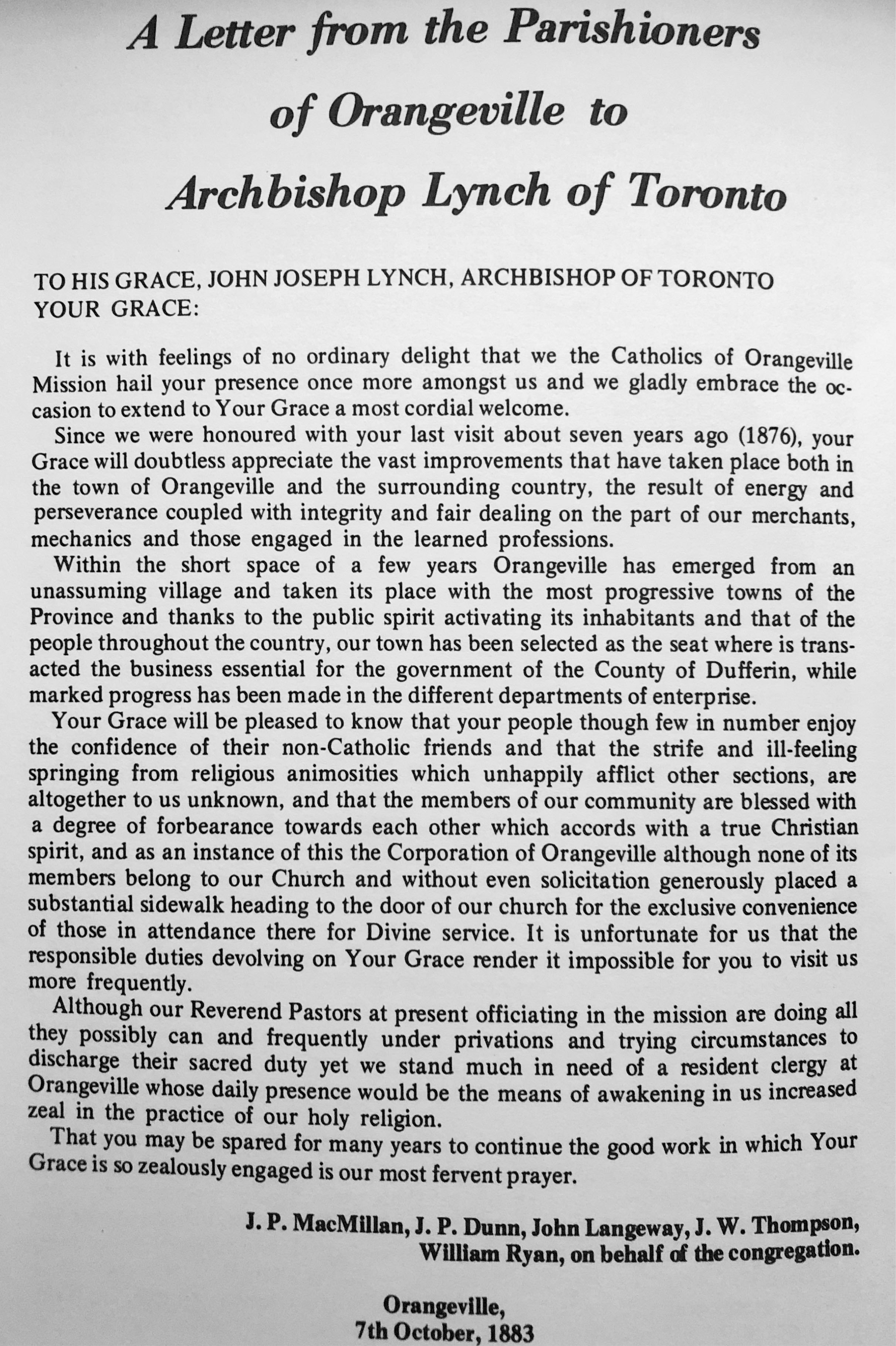
The History Of St Timothy’s Church, Orangeville
The post World War || growth of Orangeville’s Catholic population necessitated a new Church to hold the ever larger crowds who wanted to attend Mass there. For this purpose one and three quarter acres of land had already been purchased on November 21, 1961, to the east of Saint Peter School at the address of 48 Centre Street. The new church site was a triangular shaped piece of land bounded by Dawson Road on the west and Centre Street on the east and the houses south of Hillside Drive on the north side where would be the new fifty car church parking lot.
His grace, Archbishop Phillip Pocock Of Toronto proposed the building of the new church on Sunday, August 23, 1964. Numerous private donations were made by parishioners and friends of the parish especially for the purchase of church items that were particularly meaningful to them. Sir Charles John Gillooly, Knight Commander of the order of Saint Gregory , made a special bequest to the Parish for the construction of a new church that would bear the name of St Timothy in memory of his father. Hence the change of name from the old St Peter to the new St Timothy Catholic Church of Orangeville. Happily the Separate School still retains the name of St Peter as a reminder of its past association with the former church which was still functioning when the new school was first built.
Mr. William Saccoccio was engaged as the architect on September 21, 1967 and the Len Ariss Construction Co Ltd., of Guelph began work on the site on Friday, August 2, 1968, during which year the cornerstone of the new church was laid also. The first Mass in the new Church was concelebrated on the Feast Of The Sacred Heart, Friday, June 13, 1969. The first regular Sunday Mass for the parishioners was held on the following Sunday June 15, 1969. The new Church was blessed by Archbishop Pocock of Toronto at 4:00 p.m. on Sunday August 24, 1969.
The new Church has a seating capacity to hold some 450 people, which at present is usually sufficient space to seat at two services all those who wish to attend mass on the weekend. The present schedule is to have one Mass Saturday evening at 7:30 p.m. and one at 11:00 a.m. This schedule also leaves the Pastor time to celebrate the regular 9:00 a.m. Sunday morning Mass at St Cornelius Mission Church.
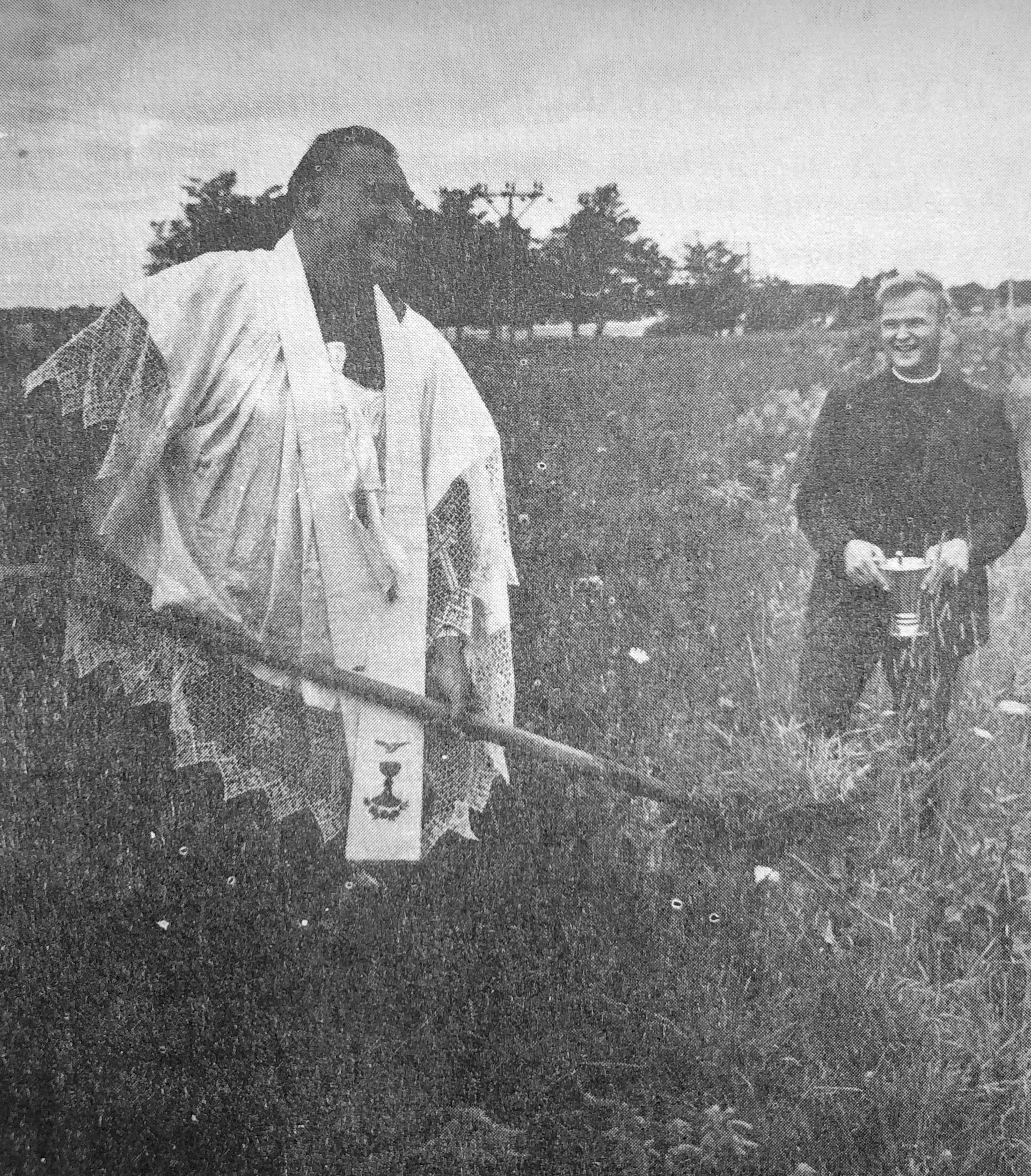
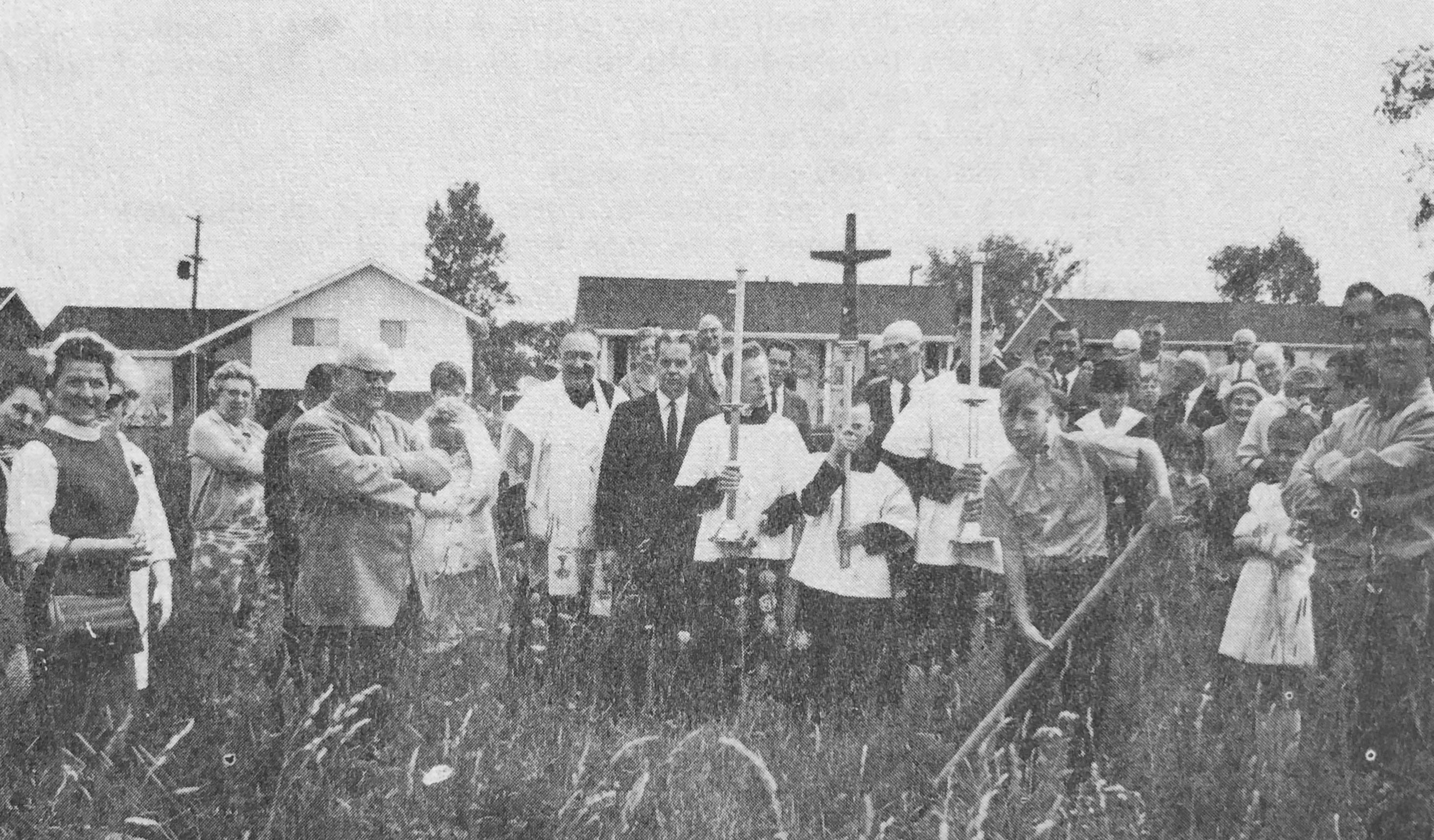
The Pastor, Father Ted Mohoney, put a great deal of personal thought into the design of this modern church. Based upon the theology of the Second Vatican Council, 1962 - 1965, the interior of the church is shaped like a triangle to represent the three Persons of the Trinity. All the furnishings by the Altar are portable so that this focal area in the front of the church can be used for many purposes such as religious drama and choir singing. The Eucharistic Presence in the Tabernacle is in a special Alcove directly facing the altar at the back of the interior of the church between the two front entrances. There are also two special Alcoves, one at each of the two main entrances to the church. The one on the west by Dawson Road is for the statue of the month and private devotion, the one on the east side by centre street is for works of religious art. St Timothy Church is truly a beautiful addition to the religious landscape of Orangeville!
